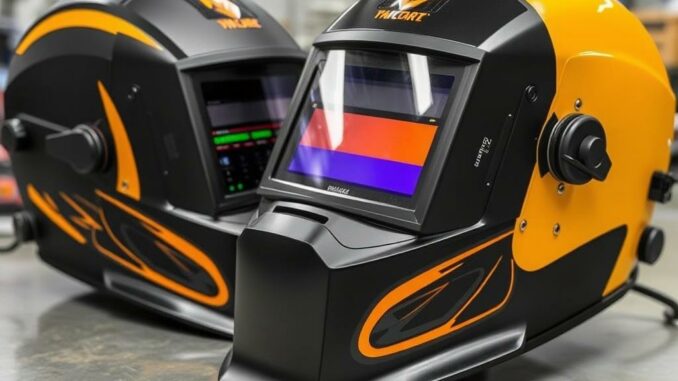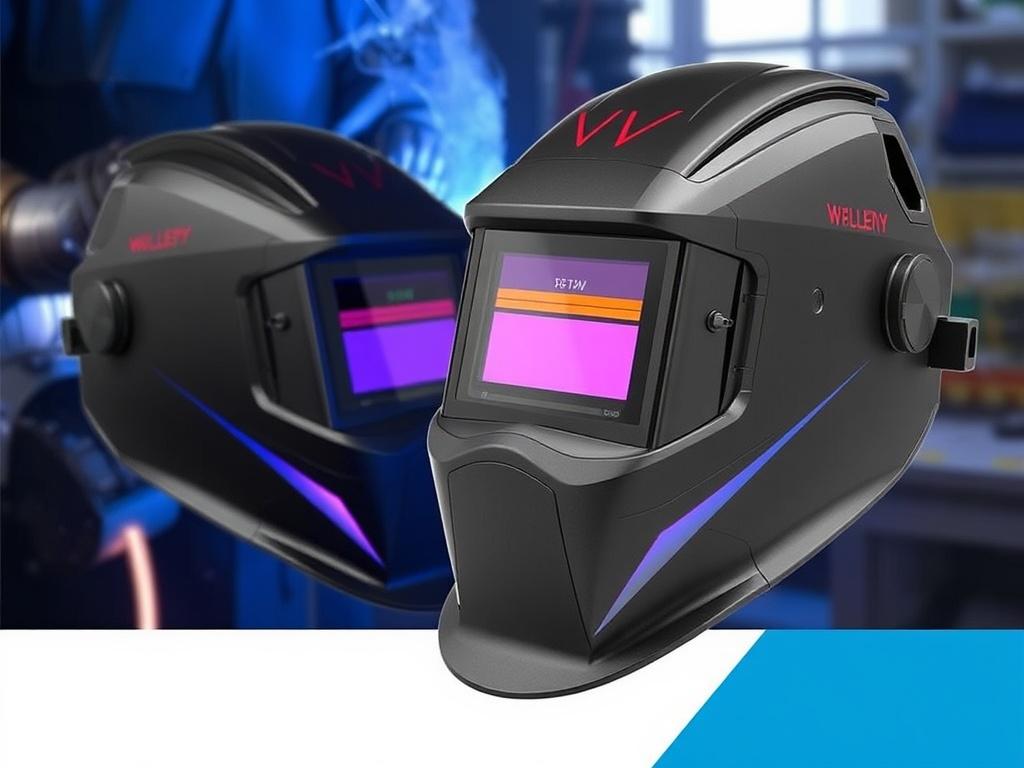
Welding is a craft that demands precision, safety, and efficiency. Whether you’re a professional welder or a hobbyist, having the right equipment makes all the difference. One of the most critical pieces of gear you can invest in is a welding helmet. With technology advancing every day, wireless welding helmets with advanced features have revolutionized the market, combining safety, comfort, and convenience into a single tool.
In this article, we’ll explore everything you need to know about wireless welding helmets with advanced features — from the technology behind them to how they improve your work, the best models available, and key considerations before you buy. We’ll guide you through the features that set these helmets apart, so you can weld confidently, comfortably, and with the latest tools at your disposal.
What Are Wireless Welding Helmets?

The term “wireless welding helmet” might seem straightforward, but it represents a significant leap forward in welding technology. Traditional welding helmets are wired or completely manual, with a fixed shade lens or shade adjusted by hand. A wireless welding helmet, on the other hand, uses wireless technology to connect with other devices or controls, adding a variety of advanced features.
These helmets integrate sensors, auto-darkening technology, and wireless controls to provide a seamless experience. Instead of fiddling with dials and buttons on the helmet, users can control settings remotely or benefit from smarter, more responsive lenses that automatically adjust based on welding conditions.
This evolution means more than just the absence of wires; it translates to safety improvements, greater flexibility, and ultimately, enhanced productivity. If you’re wondering why these helmets matter, consider that the welder’s environment is already challenging — heavy gear, sparks, bright light, and physical strain. Wireless welding helmets with advanced features are designed to relieve some of these challenges.
How Does Wireless Technology Enhance Welding Helmets?
Wireless technology in welding helmets mainly involves Bluetooth or similar connections that allow the helmet to communicate with controllers, smartphones, or other devices. This connectivity makes it possible to:
- Adjust settings remotely: Change the lens shade, sensitivity, and delay time without removing the helmet.
- Log welding data: Some helmets can record usage data and transmit it for review or training purposes.
- Receive alerts: Wireless helmets can notify welders about battery life or maintenance needs.
- Integrate with augmented reality: Using heads-up displays to project vital information right inside the helmet.
These features translate to fewer interruptions and greater awareness, allowing welders to focus on the task with the utmost safety and precision.
The Core Advanced Features of Wireless Welding Helmets
Not all wireless welding helmets are created equal. Depending on your needs, welding type, and budget, the features you prioritize may vary. Below, we examine some of the most advanced features that set wireless welding helmets apart from traditional models.
1. Auto-Darkening Technology with Wireless Control
The foundation of most modern welding helmets is their auto-darkening capability. This feature instantaneously adjusts the lens shade based on the intensity of the welding arc. Traditionally, welders had to manually adjust lens shades before starting, but now, sensors detect the arc’s brightness and change the lens accordingly in milliseconds.
Wireless control adds a new dimension: welding professionals can adjust the sensitivity, shade level, and delay times remotely using mobile apps or dedicated controllers. This means you don’t have to remove your helmet or stop working to tweak these settings.
2. Integrated Heads-Up Display (HUD)
Imagine having critical welding data projected inside your helmet so you can access information without looking away from your work. Advanced wireless welding helmets can incorporate HUDs, presenting data such as:
- Current shade level
- Battery status
- Welding time tracking
- Notifications and warnings
HUDs increase situational awareness and help welders maintain optimal work quality by providing real-time feedback.
3. Enhanced Comfort and Ergonomics with Tactical Wireless Control
Welding is physically demanding, and extended wear of heavy helmets can cause fatigue. Advanced helmets focus on ergonomics, utilizing balanced designs, softer padding, and lightweight materials. Some wireless models allow you to control helmet settings via wrist or chest-worn wireless remotes, reducing the need for awkward helmet adjustments.
4. Bluetooth Connectivity and Mobile App Integration
Bluetooth-enabled helmets pair with smartphone apps to offer a comprehensive user interface for configuration and data management. These apps make it easier to save personalized presets depending on different welding jobs or materials. Additionally, they provide diagnostic tools, firmware updates, and even tutorials.
5. Solar-Powered Batteries with Wireless Charging
Powering wireless helmets sustainably is essential. Many models combine solar cells with rechargeable batteries that support wireless charging pads. This feature reduces downtime and mitigates battery replacement frequency. Staying powered longer means uninterrupted workflow in tight deadlines.
Benefits of Using Wireless Welding Helmets with Advanced Features
Why should you consider upgrading to a wireless welding helmet with advanced features? The advantages extend beyond just “cool technology” — they improve both your welding output and safety. Let’s explore the benefits in detail.
Improved Safety and Eye Protection
Welding exposes your eyes to harmful UV and IR radiation, and traditional helmets lack precise responsiveness. Advanced wireless helmets offer superior auto-darkening technology that reacts faster to flashes. Their accurate shade adjustments prevent overexposure or insufficient protection, reducing eye strain and long-term damage risks.
Enhanced Productivity and Workflow
Every second counts on the job site. Wireless control and mobile app integration mean you can adjust settings on the fly without removing your helmet. This streamlined workflow reduces disruptions, allowing you to complete tasks more efficiently. In addition, logging features also help track work hours and tasks for better project management.
Customization and Versatility
Modern wireless helmets cater to a wide range of welding processes — MIG, TIG, Stick, Plasma, and more — by offering adjustable settings specific to each. With mobile apps, you can switch between profiles easily. This flexibility ensures you have optimal protection and visibility no matter the job.
Comfort for Long Duration Use
Ergonomically designed wireless helmets are lighter and better balanced. Combined with remote controls, welders experience less neck and back strain. The increased comfort allows for longer work periods without fatigue, increasing overall job satisfaction.
How to Choose the Best Wireless Welding Helmet with Advanced Features
With so many options available, selecting the right wireless welding helmet can feel overwhelming. Consider these factors to make an informed decision:
| Factor | What to Look For | Why It Matters |
|---|---|---|
| Auto-Darkening Speed | Faster response times (within microseconds) | Reduces the risk of eye injury and improves workflow |
| Wireless Connectivity | Bluetooth-enabled with app control | Offers remote adjustments and customization |
| Battery Life | Long-lasting, solar-assisted, wireless charging compatible | Minimizes downtime and maintenance |
| Helmet Weight | Lightweight, balanced designs | Prevents fatigue during long use |
| Field of View | Large viewing area with high optical clarity | Improves accuracy and reduces neck strain |
| Compatibility | Supports multiple welding processes (MIG, TIG, Stick, Plasma) | Enhances versatility across jobs |
| Comfort Features | Adjustable padding, ventilation, anti-fog lenses | Improves wearability and safety |
| Price and Warranty | Reasonable cost, robust warranty support | Ensures value and peace of mind |
Additional Tips for Selecting Wireless Welding Helmets
- Read reviews: User experiences provide insight beyond specs.
- Test fit: Try the helmet to ensure comfort and a good seal.
- Confirm compatibility: Make sure the helmet works with your welding equipment.
- Consider after-sales support: Reliable customer service can be crucial.
Top Wireless Welding Helmets with Advanced Features in the Market

Several manufacturers are leading the way in wireless welding helmet technology. Below is a list of notable models renowned for their advanced features and reliability.
| Helmet Model | Key Advanced Features | Price Range | Ideal For |
|---|---|---|---|
| Lincoln Electric VIKING 3350 | True Color Lens, Bluetooth app support, large viewing area, auto-darkening | $$$ | Professional welders doing varied welding types |
| 3M Speedglas 9100 FX | Wireless remote control, ergonomic design, solar-powered, enhanced optics | $$$$ | Industrial use and heavy-duty welders |
| Optrel Crystal 2.0 | OLED display, Bluetooth settings, unparalleled clarity, lightweight | $$$$ | Precision welding and fabricators focused on image clarity |
| Yeswelder True Color Auto Darkening Welding Helmet | Wireless control app, solar assist, ultra-clear lens, affordability | $$ | Hobbyists and entry-level professionals |
| TIGER Wiresless Welding Helmet | Wireless controls, auto-darkening, lightweight, USB rechargeable | $$ | Both professionals and DIY enthusiasts needing mobility |
Maintaining Your Wireless Welding Helmet for Longevity
Wireless welding helmets with advanced features are a valuable investment. Proper maintenance extends their life and preserves their performance.
Regular Cleaning
Keep the lens and sensors clean from dust, welding spatter, and debris. Use soft cloths and recommended cleaning solutions. Avoid abrasive materials that may scratch lenses.
Battery Care
Charge batteries according to manufacturer instructions. Use wireless charging stations if available and avoid overcharging. Solar power helps maintain battery health when possible.
Check Wireless Connections
Periodically verify Bluetooth or wireless connections, update firmware through apps, and troubleshoot any connectivity issues. This ensures smooth operation on the job.
Storage
Store your helmet in a cool, dry place, ideally in a protective case. This prevents physical damage and prolongs sensor and electronic longevity.
Looking Ahead: The Future of Wireless Welding Helmets
The integration of wireless technology into welding helmets hints at a future rich with innovation. Here are some exciting trends on the horizon:
Augmented Reality (AR) Integration
Imagine helmets that not only protect your eyes but also overlay welding instructions, measurements, or real-time diagnostics via AR — boosting precision and learning.
AI-Assisted Welding
Artificial intelligence could monitor weld quality in real time, providing guidance on technique adjustments to improve results directly inside the helmet’s display.
Improved Connectivity Within Job Sites
Helmets connected to central systems may sync job logs, safety alerts, and equipment statuses, making management seamless.
Eco-Friendly and Sustainable Designs
Expect enhanced solar power capabilities and recyclable materials aimed at reducing environmental impact.
Conclusion: Is a Wireless Welding Helmet with Advanced Features Right for You?
If you’re serious about welding, investing in a wireless welding helmet with advanced features is a smart move. It improves not only your safety but your ability to work efficiently and comfortably. These helmets offer unparalleled convenience through remote controls, app integration, and superior technology like auto-darkening and heads-up displays.
Whether you’re tackling complex industrial jobs or weekend projects, wireless welding helmets adapt to your style and needs. When selecting your next helmet, consider the features that will offer real value — auto-darkening speed, wireless connectivity, comfort, and battery life. And remember, proper maintenance ensures your equipment stays reliable for years.
Wireless welding helmets with advanced features are more than a trend; they represent the future of welding safety and productivity. Embrace this technology and elevate your welding game to new heights!
